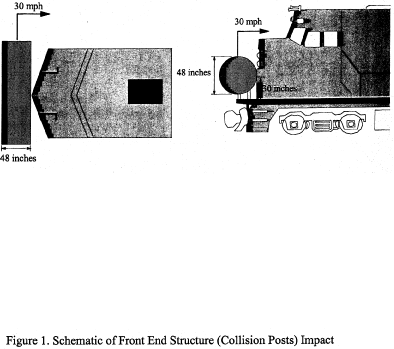Appendix E to Part 229 - Performance Criteria for Locomotive Crashworthiness
49:4.1.1.1.23.7.31.1.55 : Appendix E
Appendix E to Part 229 - Performance Criteria for Locomotive
Crashworthiness
This appendix provides performance criteria for the
crashworthiness evaluation of alternative locomotive designs, and
design standards for wide-nosed locomotives and any for other
locomotive, except monocoque/semi-monocoque design locomotives and
narrow-nose design locomotives. Each of the following criteria
describes a collision scenario and a given performance measure for
protection provided to cab occupants, normally through structural
design. Demonstration that these performance criteria have been
satisfied may be accomplished through any of the methods described
in § 229.205. This performance criteria is intended to prevent
intrusion into the cab seating area occupied by crews. This
excludes inner and outer vestibule areas.
(a) Front end structure (collision posts) - (1)
Objective. The front end structure of the locomotive must
withstand a frontal impact with a proxy object which is intended to
simulate lading carried by a heavy highway vehicle (see figure
1).
(2) Proxy object characteristics and orientation. The
proxy object must have the following characteristics: Cylindrical
shape; 48-inch diameter; 126-inch length; 65,000 pound minimum
weight; and uniform density. The longitudinal axis of the proxy
object must be oriented horizontally perpendicular to the
longitudinal axis of the locomotive.
(3) Impact and result. The front end structure of the
locomotive must withstand a 30-mph impact with the proxy object
resulting in no more than 24 inches of crush along the longitudinal
axis of the locomotive, measured from the foremost point on the
collision post, and with no more than 12 inches of intrusion into
the cab. The center of impact must be 30 inches above the top of
the locomotive underframe along the longitudinal centerline of the
locomotive.

(b) Front end structure (short hood) (1)
Objective. The front end structure of the locomotive must
withstand an oblique impact with a proxy object intended to
simulate an intermodal container offset from a freight car on an
adjacent parallel track (see figure 2).
(2) Proxy object characteristics and orientation. The
proxy object must have the following characteristics: Block shape;
36-inch width; 60-inch height; 108-inch length; corners having
3-inch radii corners; 65,000 pound minimum weight; and uniform
density. The longitudinal axis of the proxy object must be oriented
parallel to the longitudinal axis of the locomotive. At impact, the
proxy object must be oriented such that there are 12 inches of
lateral overlap and 30 inches from the bottom of the proxy object
to the top of the locomotive underframe.
(3) Impact and results. The front end structure of the
locomotive must withstand a 30-mph impact with the proxy object
resulting in no more than 60 inches of crush along the longitudinal
axis of the locomotive, measured from the first point of contact on
the short hood post, and with no more than 12 inches of intrusion
into the cab.

[71 FR
36915, June 28, 2006]